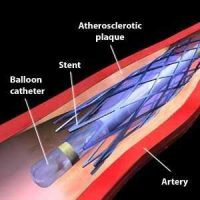- Home
- Editorial
- News
- Practice Guidelines
- Anesthesiology Guidelines
- Cancer Guidelines
- Cardiac Sciences Guidelines
- Critical Care Guidelines
- Dentistry Guidelines
- Dermatology Guidelines
- Diabetes and Endo Guidelines
- Diagnostics Guidelines
- ENT Guidelines
- Featured Practice Guidelines
- Gastroenterology Guidelines
- Geriatrics Guidelines
- Medicine Guidelines
- Nephrology Guidelines
- Neurosciences Guidelines
- Obs and Gynae Guidelines
- Ophthalmology Guidelines
- Orthopaedics Guidelines
- Paediatrics Guidelines
- Psychiatry Guidelines
- Pulmonology Guidelines
- Radiology Guidelines
- Surgery Guidelines
- Urology Guidelines
Guidelines on use of CT Angio in Patients with stable chest pain

A prospective randomized controlled trial was conducted to evaluate use of CTCA in patients without prior coronary heart disease who present with typical angina, atypical angina, or non-anginal chest pain and abnormal resting ECG.The study published in JACC ,it has been found that CTCA provides minimal benefit in patients with non-anginal chest pain and normal ECG while increasing the rate of cardiac catheterization.
This study is a post-hoc analysis of the previously published SCOT-HEART (Scottish Computed Tomography of the HEART Trail) investigation, a prospective randomized controlled trial that included 3,770 participants in Scotland who were referred for evaluation of suspected stable angina of recent onset and had no prior history of coronary heart disease. Participants were randomized to receive either computed tomography coronary angiography (CTCA) with standard care or standard care alone. In order to evaluate a 2016 update to the National Institute for Health and Care Excellence clinical guideline on chest pain of recent onset, this post-hoc analysis further categorized participants into two groups: 1) a non-anginal cohort consisting of 1,447 patients with non-anginal chest pain and normal electrocardiogram (ECG) and 2) a possible angina cohort consisting of 2,323 patients with typical angina, atypical angina, or non-anginal chest pain and an abnormal resting ECG (defined as the presence of pathological Q waves, left bundle branch block, or ST-segment or T wave abnormalities). Outcome data were updated on June 29, 2016, with a median duration of follow-up of 3.2 years.
Primary endpoints were diagnostic certainty at 6 weeks and incidence of fatal and non-fatal myocardial infarction (MI):
- CTCA improved diagnostic certainty at 6 weeks in both groups. The benefit was greater in the possible angina cohort (34.9% vs. 15.7%, p < 0.001) than in the non-anginal cohort (32% vs. 25.2%, p = 0.002).
- CTCA use was associated with a significantly reduced incidence of MI in the possible angina cohort (1.9% vs. 3.2%, p = 0.045); a reduced incidence of MI in the non-anginal cohort did not reach statistical significance (1.0% vs. 1.5%, p = 0.379).
Secondary endpoints included 1) rates of cardiac catheterization, 2) changes in cardiovascular drugs prescribed, 3) coronary revascularization, 4) all-cause death, and 5) non-fatal stroke:
- CTCA significantly increased the rate of cardiac catheterization for the non-anginal cohort in the overall follow-up period (6.6% vs. 3.7%, p = 0.014). In contrast, the cardiac catheterization rate for the overall follow-up period did not increase in the anginal cohort (30.2% in CTCA group vs. 32.1% in standard of care group, p = 0.481).
- The use of CTCA was associated with changes in cardiac medications in 26.8% of participants in the possible angina cohort versus 19.4% in the non-anginal cohort (and resulted in a changed diagnosis in 29% of participants in the possible angina cohort vs. 16.9% in the non-anginal cohort).
- The rate of coronary revascularization, all-cause death, or non-fatal stroke was not significantly changed by utilization of CTCA in either the anginal or non-anginal cohort.
CTCA findings:
- The possible angina cohort was much more likely to display evidence of obstructive coronary artery disease on CTCA (29.7% vs. 9.5%, p < 0.001) compared with the non-anginal cohort.
- The non-anginal cohort was more likely to show normal coronary arteries on CTCA (50.1% vs. 33.1%, p < 0.001) compared with the possible angina cohort.
Cardiac catheterization findings:
- The possible angina cohort randomized to CTCA showed a reduced likelihood of having normal coronaries at catheterization (relative risk 0.32, p < 0.001) and an increased likelihood of having obstructive coronary artery disease (relative risk 1.18, p = 0.002).
- In contrast, the non-anginal cohort randomized to CTCA had a similar likelihood of normal coronaries at catheterization (relative risk 0.78, p = 0.622) compared with standard care alone and a similar likelihood of obstructive coronary artery disease (relative risk 0.82, p = 0.422).
It was concluded that in patients with typical or atypical angina or abnormal resting ECG, CTCA significantly increased diagnostic certainty and reduced the risk of MI without impacting the incidence of cardiac catheterization. In contrast, for patients with non-anginal chest pain and normal resting ECG, CTCA was less likely to increase diagnostic certainty, did not reduce the risk of MI, significantly increased the rate of cardiac catheterization, and changed neither the normal coronary rate nor the rate of obstructive coronary artery disease found at cardiac catheterization. These findings provide clinical evidence to support the 2016 update to the National Institute for Health and Care Excellence guidelines on chest pain of recent onset.
cardiac catheterizationcardiovascular drugscomputed tomography coronary angiographyCoronary Revascularizationmyocardial infarctionNICE guidelinestomography
Next Story
NO DATA FOUND

Disclaimer: This site is primarily intended for healthcare professionals. Any content/information on this website does not replace the advice of medical and/or health professionals and should not be construed as medical/diagnostic advice/endorsement or prescription. Use of this site is subject to our terms of use, privacy policy, advertisement policy. © 2020 Minerva Medical Treatment Pvt Ltd